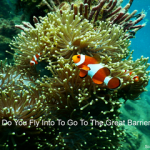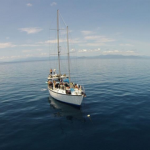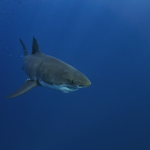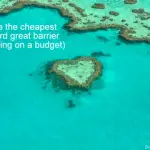
What is the best time to visit the Great Barrier Reef to go scuba diving?
The Great Barrier Reef is what gave me the bug for scuba diving. It was where I did my very first dive. It’s spectacular! After all it’s one of the Seven Wonders Of The Natural World. So to really enjoy your trip it’s best to know what is the best time to visit the Great Barrier Reef.
The best time to visit the Great Barrier Reef is June to October. October is the overall best time to visit. It’s a good month for scuba diving as visibility is good, it’s warm and there’s less chance of rain. Plus it’s not too overrun with tourists. In October the water temperature is 25.8°C (78.4F).
The waters are warmest in December, January, February and March and coldest June through September. The peak wet season is January through March, when it can get uncomfortably humid.
If you want to see Humpback Whales and Dwarf Minke Whales, July and August would be your best bet. The best way to experience everything that The Great Barrier Reef has to offer, which includes night diving, is on a liveaboard. Be aware of stinger season or jelly fish season between November and May. But these tend to be closer to the coast. On the outer Barrier Reef stingers generally aren’t a problem.
The Great Barrier Reef is the largest of all marine parks to scuba dive. It’s a great place for both experienced divers and beginner scuba divers to enjoy.
The best way to dive the Great Barrier Reef, Australia is by a scuba diving liveaboard, especially the outer reefs. You can check the latest and best deals on liveaboards using the following window:
What is the best time to visit the Great Barrier Reef
If you want to scuba dive the Great Barrier Reef you can do this all year round. But of course there are best times to visit to get the most out of your scuba diving trip.
Between the months of June and September you have the opportunity to see Humpback Whales and Dwarf Minke Whales on the Great Barrier Reef.
There’s also plenty that goes on at different times of the year when you are more likely to see certain creatures and be witness to certain events.
If you would like to see breaching Humpback Whales, these can be seen on the Great Barrier Reef between June and September and possibly in May. But Humpbacks aren’t the only whales to visit this region. In June through September you can see the Dwarf Minke Whales too.
The Great Barrier Reef is the only place where you get to snorkel with this not so dwarf-like creature standing in at over 8 metres (26+ feet) in length.
The Great Barrier Reef is home to such a huge diversity of marine life. It’s home to over 1,500 species of fish, over 400 types of coral. More than 180 shark and ray species together with a healthy population of sea turtles too.
Find out more here about six of seven sea turtles found on The Great Barrier Reef.
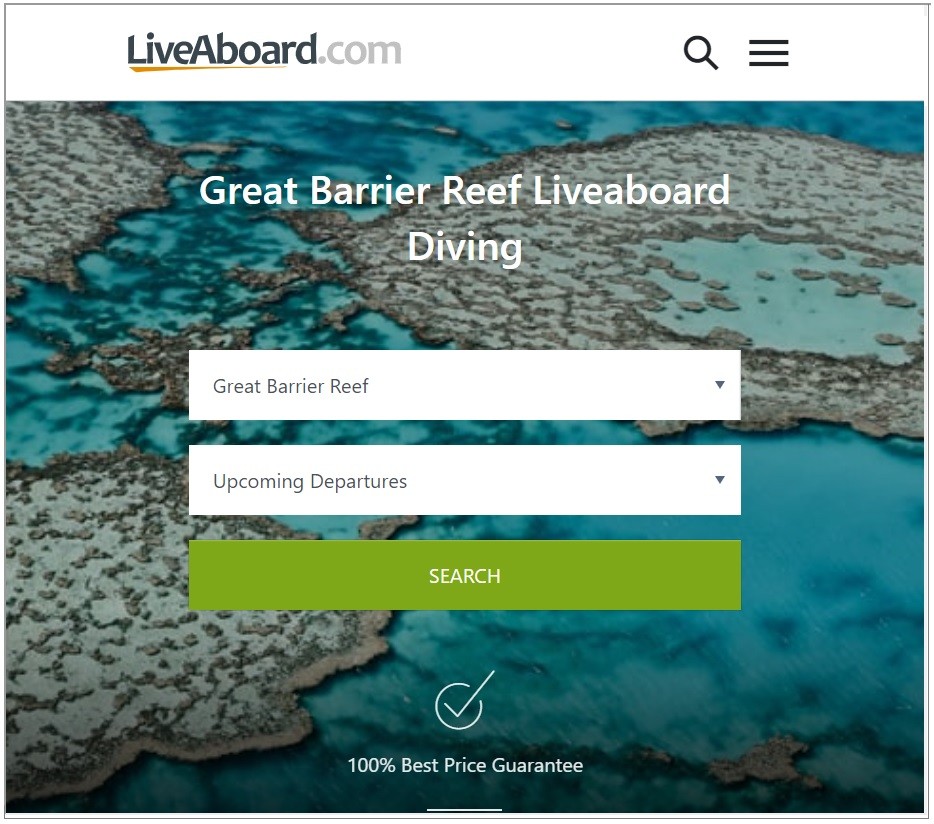
Can you go scuba diving in the Great Barrier Reef?
Scuba diving the Great Barrier Reef has got to be one of the best places in the World to dive. It’s one of those bucket list places. It’s on my ‘return-to-list‘ places. Writing this article has made me realise how wonderful it is.
You get to see the biggest coral reef in the world and the abundance of sea life that lives there.
Probably one of the richest places on the planet for sea life. You see small fish through to larger fish like sharks and rays, including the infamous Manta Ray. But then there’s also the chance to see the biggest fish of them all, the Whale Shark.
You may also like to read about the best place to dive with whale sharks. Do you know what predators whale sharks have or do they give birth to live young? These questions along with others are answered in this article too.
You don’t have to scuba dive to enjoy this beautiful place, as you can also see it all by snorkelling too. Or why not do both. If you scuba dive the Great Barrier Reef from a liveaboard, you can also snorkel in-between your dives.
You can dive from January through to December, but some months are better than others. The best months are from June to October as these are the months when there’s less rainfall, it’s less humid and the water is at its clearest.
However, be aware of the south trade winds in the months of July to September, as the waters become choppy in these months. Not good if you suffer from sea sickness!
At the end of this detailed review of each month on the Great Barrier Reef, you’ll find a handy table. The table summarises the following information for easy reference.
Here’s a review of each month in the season for scuba diving the Great Barrier Reef.
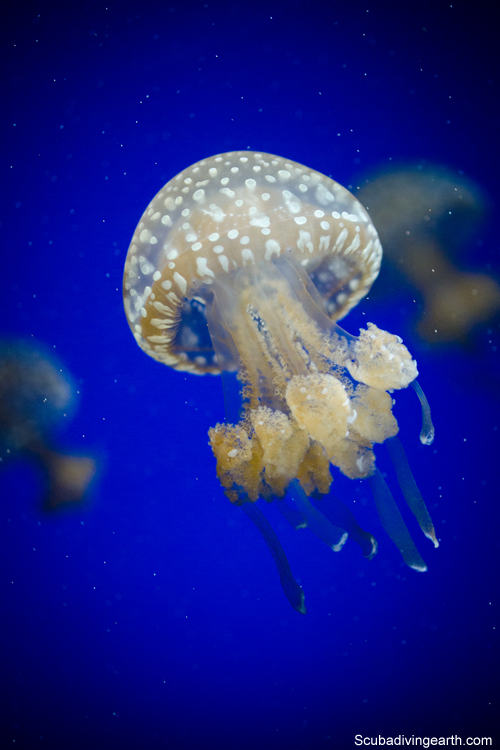
What to expect on the Great Barrier Reef in January
January is the wet season and very humid and there’s a chance of cyclones, plus it’s stinger (jellyfish) season.
But very few jelly fish are seen out on the reefs where scuba diving and snorkelers go.
Its the end of turtle nesting season, but the start of turtle hatching. Water visibility can be affected if there’s bad run-off, but this mostly doesn’t affect the outer reefs.
Its a good time to see Manta Rays. I suggest you wear at least Lycra protection in case of jellyfish, unless you’re like me and prefer a 3mm wetsuit.
If you are interested, you may also like to read about 40+ interesting facts about manta rays. For example, do you know why they have tails or what a group of mantas are called? Find out in this article, plus loads more.
Great Barrier Reef key information for January:
- Max Water Temp: 28.9°C (84°F);
- Max Air Temp: 31.4°C (88.5°F);
- Exposure suit minimum: Lycra;
- Weather: Hot, humid with rainfall (possible tropical cyclones);
- Sea state: Calm;
- Visibility: Mixed;
- Cyclone: Possible.
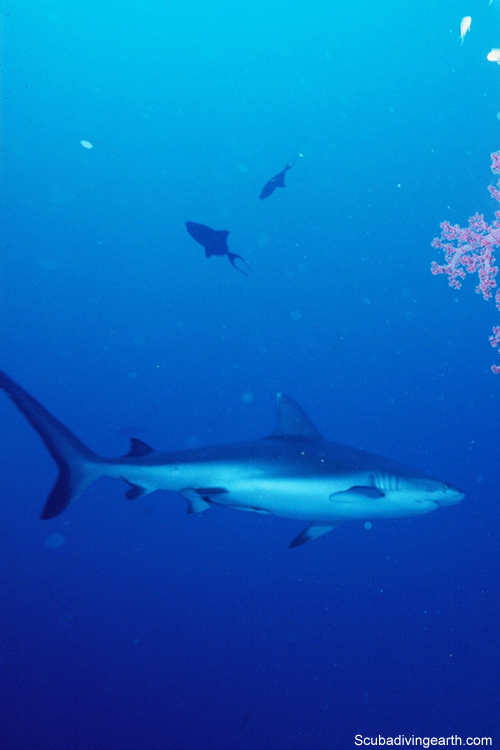
What to expect on the Great Barrier Reef in February
February is the continuation of the wet season with very high and uncomfortable humidity.
It’s still stinger season, so although jellyfish are rarely found on the reefs, a minimum of Lycra protection is recommended.
Turtles are still hatching at this time, so you may be able to see the turtle hatchlings at some point on your trip. This is still cyclone season, but the seas are calm.
Visibility can be affected by run-off, so a liveaboard dive trip may be the best option. Still a good time to see Manta Rays.
Great Barrier Reef key information for February:
- Max Water Temp: 29°C (84.2°F);
- Max Air Temp: 31.2°C (88.1°F);
- Exposure suit minimum: Lycra;
- Weather: Hot, humid with high rainfall (possible tropical cyclones);
- Sea state: Calm;
- Visibility: Mixed;
- Cyclone: Possible.
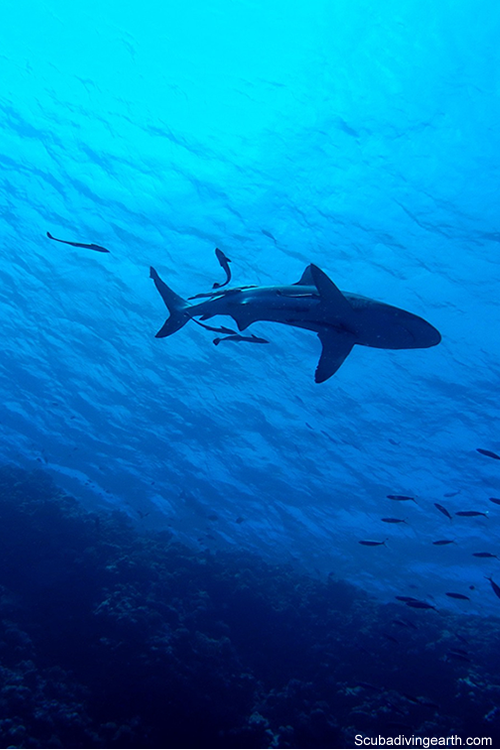
What to expect on the Great Barrier Reef in March
March is the last month of turtle hatching. Still the wet season and humidity is still high, with the risk of cyclones.
However, the seas are calm and the waters are warm. The water temperature is still above 28°C (83°F), but as there are still jellyfish around a Lycra body suit is still the minimum body protection recommended.
It’s still a good time to see Manta Rays at North Stradbroke Island where they congregate to mate. Black Tip Reef Sharks give birth in March and come closer to the shoreline.
Great Barrier Reef key information for March:
- Max Water Temp: 28.5°C (83.3°F);
- Max Air Temp: 30.6°C (87.1°F);
- Exposure suit minimum: Thin wetsuit;
- Weather: Hot, humid and still expect high rainfall;
- Sea State: Calm;
- Visibility: Mixed;
- Cyclone: Possible.
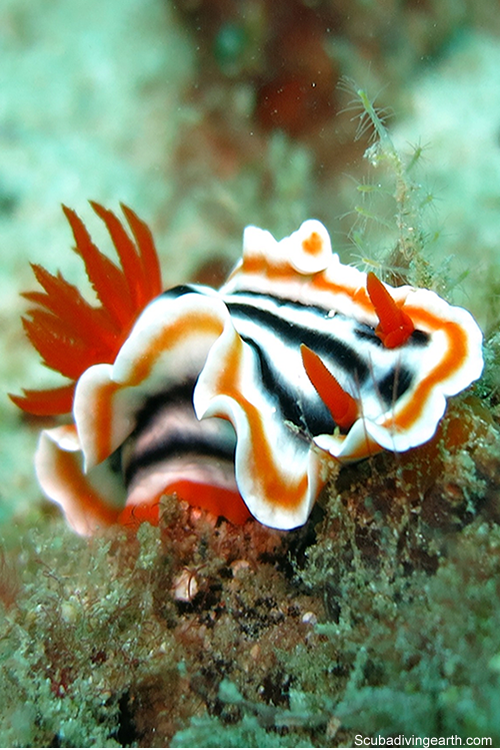
What to expect on the Great Barrier Reef in April
Although April is still officially the wet season, the rainfall is lower. Still humid and a continuation of stinger season. Air temperature is still above 29C (84F).
Sea state is calm, but there’s still the chance of a cyclone in this month. You may consider switching to a thin wetsuit as the water temperature has dropped to 27.5°C (81.5°F).
Some consider April as one of the best months to visit the Great Barrier Reef. A tip is to look out for nudibranchs, which are colourful creatures and great to see.
Great Barrier Reef key information for April:
- Max Water Temp: 27.5°C (81.5°F);
- Max Air Temp: 29.2°C (84.6°F);
- Exposure suit minimum: Thin wetsuit;
- Weather: Hot, humid with minimal rainfall;
- Sea state: Calm;
- Visibility: Mixed;
- Cyclone: Possible.

What to expect on the Great Barrier Reef in May
The wet season has ended so there’s very little rain in May. It’s one of the cheapest times to fly to Australia too. There are still jelly fish around the coasts, but this is the last month of stinger season.
The air and water temperature is roughly the same at around 26-27°C (79-81°F), so I recommend a thin wetsuit for body protection.
May is the first possibility to see Humpback Whales, but some suggest you’ll not see them until June. It’s also a good time to see a proliferation of Manta Rays at Lady Elliott Island (Named home to the Manta Rays).
Great Barrier Reef key information for May:
- Max Water Temp: 26.2°C (79.2°F);
- Max Air Temp: 27.6°C (81.7°F);
- Exposure suit minimum: Thin wetsuit;
- Weather: Warm, minimal rainfall;
- Sea state: Calm;
- Visibility: Mixed;
- Cyclone: Possible.
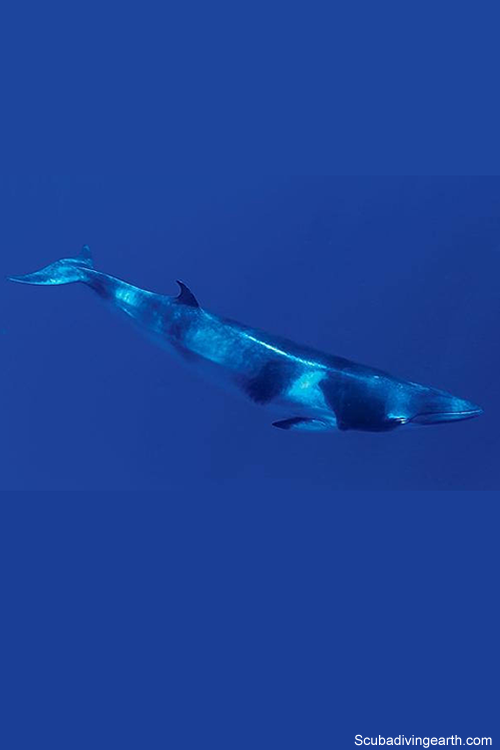
What to expect on the Great Barrier Reef in June
June is the beginning of the best water visibility on the Great Barrier Reef, but is also the time when the temperature has dropped too. I recommend a slightly thicker wetsuit to keep you warm in the 25°C (77°F) waters.
June is the first month to see Dwarf Minke Whales (8 metres (26 feet) in length), although some say July is the first month. The Great Barrier Reef is the only place in the world where you can snorkel with these beautiful creatures.
The Humpbacks are still around too – so a Whale double whammy!
Great Barrier Reef key information for June:
- Water Temp: 25°C (77°F);
- Air Temp: 26°C (78.8°F);
- Exposure suit minimum: Wetsuit;
- Weather: Cooler, rainfall negligible;
- Sea state: Calm;
- Visibility: Good;
- Cyclone: No.
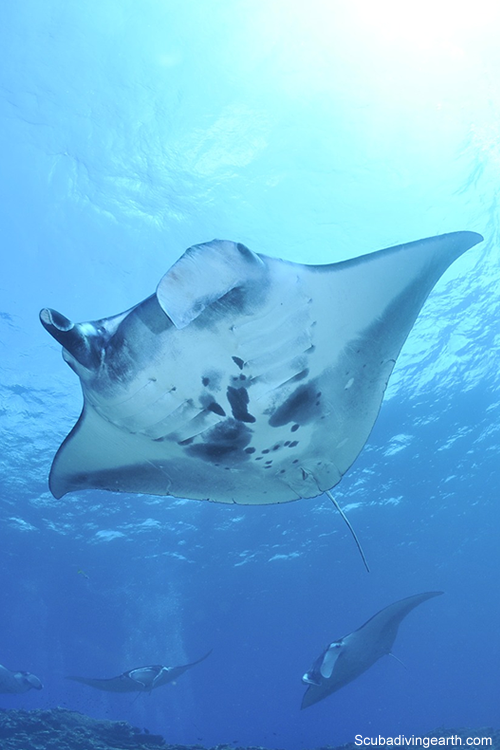
What to expect on the Great Barrier Reef in July
July is a good month for the magnificent Humpback Whales, and the Dwarf Minke Whales are still around too. Water visibility is good, but this month sees the start of the southerly trade winds.
This can create choppier sea conditions and may require travel sickness medication, if you are susceptible to sea sickness. The water temperature has dropped to just 24.3°C (75.7°F), so a thicker wetsuit is required.
This is especially true as the air temperature is not much better at this time of the year either.
Great Barrier Reef key information for July:
- Water Temp: 24.3°C (75.7°F);
- Air Temp: 25.7°C (78.3°F);
- Exposure suit minimum: thicker wetsuit;
- Weather: Cooler, rainfall negligible;
- Sea state: Choppy;
- Visibility: Good;
- Cyclone: No.
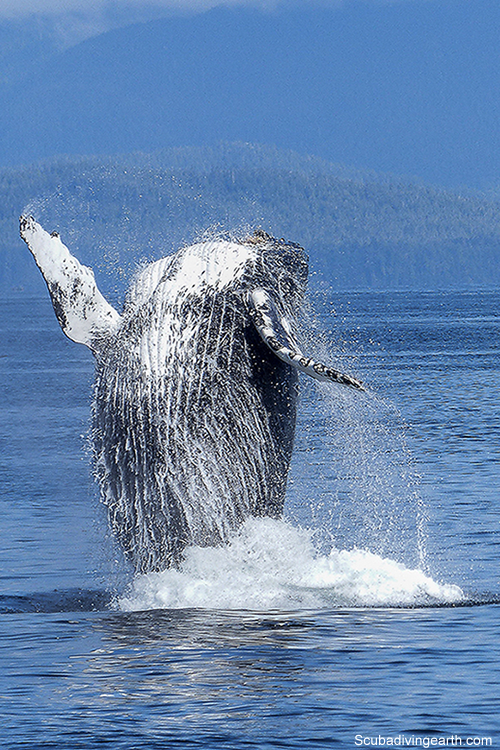
What to expect on the Great Barrier Reef in August
August is another great month for the Humpback Whales and Dwarf Minke Whales.
August is the month when you have good visibility, but also choppier seas as the south trade winds will still be blowing. The water a similar temperature to July at just 24.3°C (75.7°F), so a wetsuit is required for exposure. August is another great month to see the Manta Rays at Lady Elliott Island.
Great Barrier Reef key information for August:
- Water Temp: 24.3°C (75.7°F);
- Air Temp: 26.6°C (79.9°F);
- Exposure suit minimum: Thin wetsuit;
- Weather: Warm, rainfall negligible;
- Sea state: Choppy;
- Visibility: Good;
- Cyclone: No.
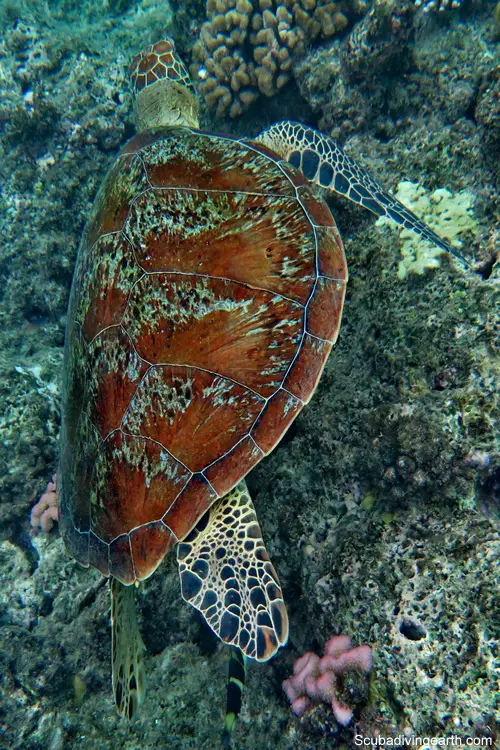
What to expect on the Great Barrier Reef in September
Time for great visibility, but the southerly trade winds are still likely to be around in September. The last chance of an opportunity to see Humpback Whales and Dwarf Minke Whales.
The Humpbacks have had their calves in the warmer waters off from Cairns. In late September they begin their long migration back down south to the rich Southern Ocean to feed through the winter.
You may be lucky to see Migaloo the white Humpback and possibly Migaloo Junior.
Great Barrier Reef key information for September:
- Water Temp: 24.9°C (76.8°F);
- Air Temp: 26.6°C (79.9°F);
- Exposure suit minimum: Thin wetsuit;
- Weather: Warm, rainfall negligible;
- Sea state: Choppy;
- Visibility: Good;
- Cyclone: No.
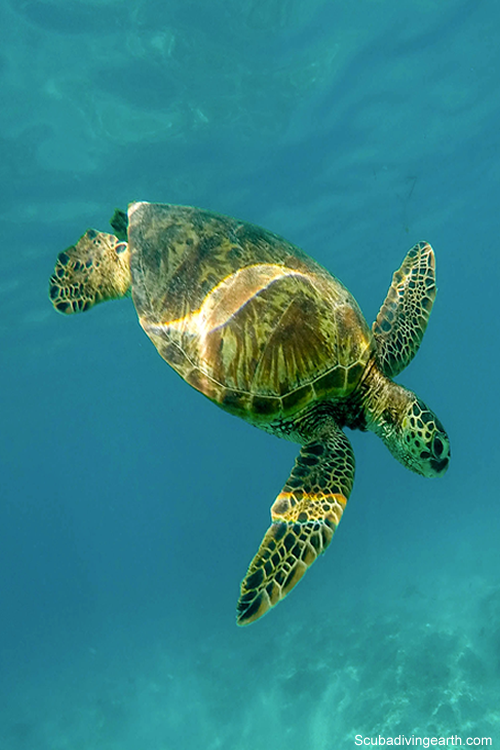
What to expect on the Great Barrier Reef in October
October seems to be voted the best month to go to the Great Barrier Reef by most. There are no stingers (jellyfish). The water is beginning to warm and is on average around 25.8°C (78.4°F). Air temperature has increase to an average of around 28.1°C (82.6°F).
There are not too many visitors in this month either and the south trade winds have stopped. The sea state is calm with great visibility.
The Manta Rays at North Stradbroke Island start to congregate to mate in October. Turtles begin to mate close to the islands, before the females return to the place they were borne to lay their eggs, which starts in November.
Great Barrier Reef key information for October:
- Water Temp: 25.8°C (78.4°F);
- Air Temp: 28.1°C (82.6°F);
- Exposure suit minimum: Thin wetsuit;
- Weather: Warm rainfall negligible;
- Sea state: Calm;
- Visibility: Good;
- Cyclone: No.
Search for your favourite Great Barrier Reef Liveaboard:
Great Barrier Reef dive liveaboards table
This list of Australia Great Barrier Reef liveaboards is in descending customer rating order, followed by Scuba Diving Luxury Rating (SDE Lux Rating, see below), so the liveaboards with the highest customer rating and the best SDE lux rating will be at the top of the list. If you want to change the list order, use the “Sort by” dropdown below.
| Discover Liveaboard | Customer Rating | SDE Lux Rating % | Flexible Booking | Dive Courses | Dietary Requirements | Nitrox | Gear Rental | |
|---|---|---|---|---|---|---|---|---|
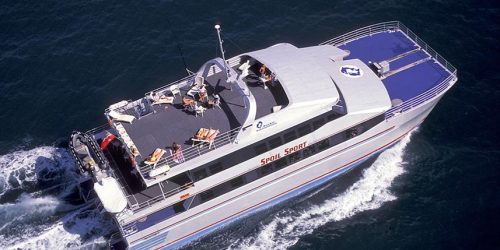 | Review: MY Spoilsport; Book: MY Spoilsport | 9.4 | 73% | YES | YES | YES | YES | YES |
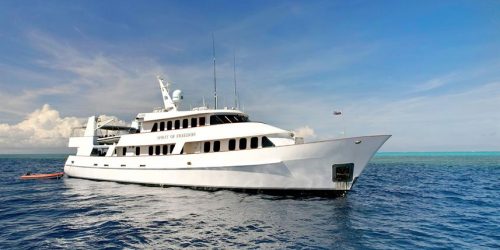 | Review: MY Spirit of Freedom; Book: MY Spirit of Freedom | 9.3 | 83% | YES | YES | YES | YES | YES |
 | Review: Coral Sea Dreaming; Book: Coral Sea Dreaming | 9.2 | 62% | YES | YES | YES | NO | YES |
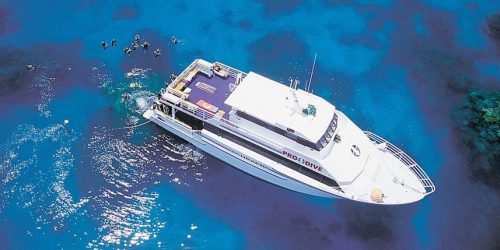 | Review: MY Pro Dive Cairns; Book: MY Pro Dive Cairns | 9.2 | 52% | YES | YES | YES | YES | YES |
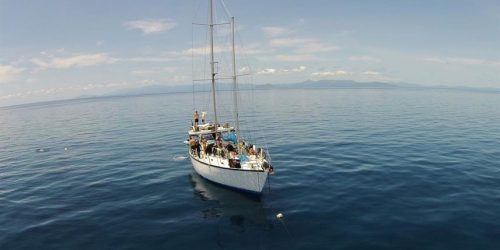 | Review: Rum Runner; Book: Rum Runner | 9 | 44% | YES | YES | YES | NO | YES |
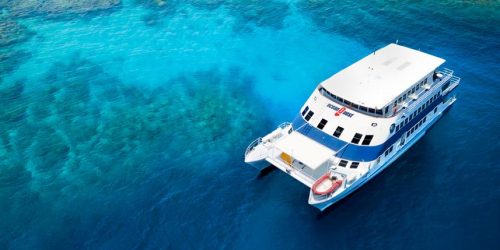 | Review: MY Ocean Quest; Book: MY Ocean Quest | 9 | 40% | YES | YES | YES | YES | YES |
The Scuba Diving Earth Luxury Rating (SDE Lux Rating) is explained on each liveaboard review when you click the “Discover Liveaboard” link, and is my own Liveaboard Luxury Rating I’ve assigned to all liveaboards. Choosing between liveaboards is helped by customer scores, and if you get stuck choosing between two or three liveaboards, where each one has a high customer score out of 10, you can use the SDE Luxury Rating to help narrow down your choice.
Think about it like using Booking.com when searching for the best hotel. Booking.com also use a customer score where each customer rates hotels out of 10. This is similar to the liveaboard customer rating, which is also rated out of 10. But let’s say you only like to stay in hotels rated 8 and above on Booking.com, but you also want the hotel to have WIFI or parking, or to have a swimming pool etc. The features each hotel has is usually secondary to the score out of 10.

What to expect on the Great Barrier Reef in November
November is when the stingers are back and the weather is hotting up. This is the start of turtle laying season when they climb out of the water onto the many islands around the Great Barrier Reef.
November is the start of the cyclone season, but the sea state is mostly calm and there is good visibility. November is also regarded as one of the better times to go before the start of the wet season.
The outer reef coral spawning can occur in November or December, a once a year occurrence so you’ll be very lucky to see this phenomenon. To see the coral spawning will involve a night dive.
The only way to night dive the Great Barrier Reef is to dive from a liveaboard dive boat.
Great Barrier Reef key information for November:
- Water Temp: 27°C (80.6°F);
- Air Temp: 30.6°C (87.1°F);
- Exposure suit minimum: Thin wetsuit;
- Weather: Warm, minimal rainfall;
- Sea state: Calm;
- Visibility: Good;
- Cyclone: Possible.
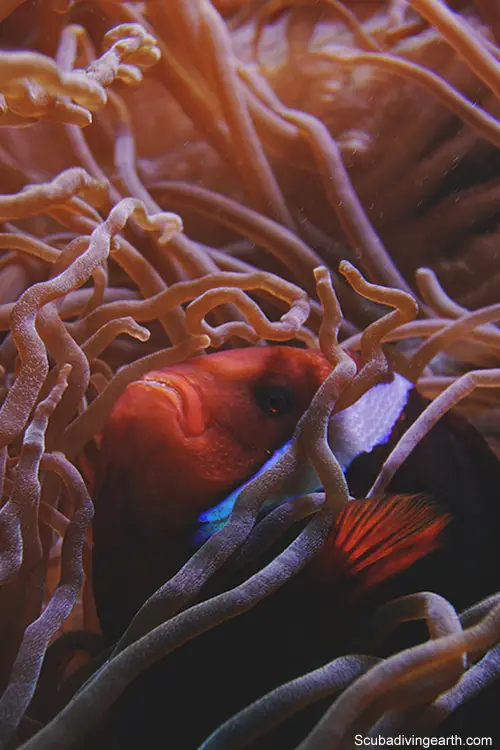
What to expect on the Great Barrier Reef in December
December is one of the hottest months along with January. It’s the start of the wet season on the Great Barrier Reef. It’s also the second chance to see the coral spawning if you are extremely lucky.
As already explained this phenomenon happens at night, so a night dive would be the time to see it.
To have an opportunity to see it you need to dive from a liveaboard dive boat. The Titan Triggerfish are also breeding and can get quite aggressive at this time, with a nasty bite so be careful.
Great Barrier Reef key information for December:
- Water Temp: 28.4°C (83.1°F);
- Air Temp: 31.4°C (88.5°F);
- Exposure suit minimum: Thin wetsuit;
- Weather: Warm and more humid, increased rainfall;
- Sea state: Calm;
- Visibility: Good;
- Cyclone: Possible.
The Best Time To Dive The Great Barrier Reef (Scroll table right for more info.)
| Month | Weather | Average daily max temperature/ sunshine | Average Water Temperature | Sea state | High/Low Season | Visibility | Exposure suit minimum | Average rainfall mm/In | Comments |
|---|---|---|---|---|---|---|---|---|---|
| 01. Scuba diving The GBR in January | Monsoon wet Season. (Green Season). Humid. Possible tropical cyclones. | 31.4°C (88.5°F) - 7hrs | 28.9°C (84°F) | Calm | Peak | Mixed | Lycra | 395.3 (15.57) | Good time to spot manta rays. Start of turtle hatching. Jellyfish stinger season. |
| 02. Scuba diving The GBR in February | Monsoon wet Season (Green Season). Humid. Possible tropical cyclones | 31.2°C (88.1°F) - 7hrs | 29.0°C (84.2°F) | Calm | Peak | Mixed | Lycra | 450.6 (17.74) | Good time to spot manta rays. Turtles still hatching. Jellyfish stinger season. |
| 03. Scuba diving The GBR in March | Monsoon wet Season (Green Season). Humid. Possible tropical cyclones. | 30.6°C (87.1°F) - 7hrs | 28.5°C (83.3°F) | Calm | Peak | Mixed | Thin wetsuit | 427.7 (16.84) | Last month of turtle hatching. Black Tip Reef Sharks give birth. Good time to see manta rays. Jellyfish stinger season. |
| 04. Scuba diving The GBR in April | End of wet season/Start of dry season Humid. Possible tropical cyclones | 29.2°C (84.6°F) - 7hrs | 27.5°C (81.5°F) | Calm | Shoulder | Mixed | Thin wetsuit | 196.5 (7.74) | Jellyfish stinger season. |
| 05. Scuba diving The GBR in May | Dry season. Cyclones still possible. Start of trade winds. | 27.6°C (81.7°F) - 7hrs | 26.2°C (79.2°F) | Calm | Low | Mixed | Thin wetsuit | 090.2 (3.55) | Jellyfish stinger season. May see humpback whales. Proliferation of Manta Rays. |
| 06. Scuba diving The GBR in June | Dry season. | 26.0°C (78.8°F) - 8hrs | 25.0°C (77°F) | Calm | Peak | Good | Thicker wetsuit | 045.5 (1.79) | Dwarf Minke Whales. Humpback whales. |
| 07. Scuba diving The GBR in July | Dry season. | 25.7°C (78.3°F) - 7hrs | 24.3°C (75.7°F) | Choppy | Peak | Good | Thicker wetsuit | 029.3 (1.15) | Dwarf Minke Whales. Humpback whales. |
| 08. Scuba diving The GBR in August | Dry season. | 26.6°C (79.9°F) - 8hrs | 24.3°C (75.7°F) | Choppy | Peak (School hols) | Good | Thicker wetsuit | 027 (1.06) | Dwarf Minke Whales. Humpback whales. Manta Rays at Lady Elliott Island. |
| 09. Scuba diving The GBR in September | Dry season. | 26.6°C (79.9°F) - 8hrs | 24.9°C (76.8°F) | Choppy | Shoulder | Good | Thicker wetsuit | 033.7 (1.33) | Dwarf Minke Whales. Humpback whales. |
| 10. Scuba diving The GBR in October | Dry season. | 28.1°C (82.6°F) - 9hrs | 25.8°C (78.4°F) | Calm | Low | Good | Thin wetsuit | 046.6 (1.83) | Best month to visit GBR. Manta Rays at North Stradbroke Island. Turtles begin to mate close to the islands. |
| 11. Scuba diving The GBR in November | Dry season. Start of cyclone season. | 30.6°C (87.1°F) - 9hrs | 27.0°C (80.6°F) | Calm | Low | Good | Thin wetsuit | 093.8 (3.7) | Turtle laying season. Jellyfish stinger season. Outer reef coral spawning. |
| 12. Scuba diving The GBR in December | Start of monsoon wet season. | 31.4°C (88.5°F) - 9hrs | 28.4°C (83.1°F) | Calm | Peak | Good | Thin wetsuit | 178.8 (7.04) | Titan Triggerfish breeding. Coral spawning. Jellyfish stinger season. |
1. Mixed water visibility is due to run-off when it rains, but the outer reef of the Great Barrier Reef won't be affect by run-off.
2. Average sea temperature information from: https://seatemperature.info/great-barrier-reef-water-temperature.html.
3. Average air temperature information from: https://www.australia.com/en-gb/facts-and-planning/weather-in-australia/cairns-weather.html.
4. Average daily sun from: https://www.holiday-weather.com/cairns/averages/.
5. To scroll on desktop select table and use arrow keys. On touch screen including mobile devices scroll the table using the screen.
Video of Migaloo the rare white (or albino) humpback whale:
The elusive all-white humpback whale known as Migaloo has been spotted heading north along Australia’s east coast for his annual migration.
Why is the Great Barrier Reef so special?
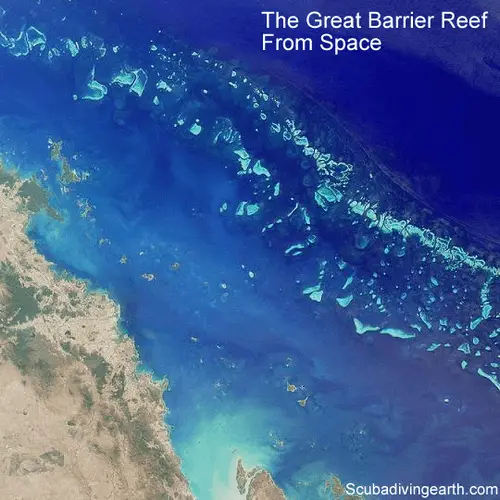
The Great Barrier Reef is so special because of its size, it covers an area the size of Germany. But not only that, it’s the shear number of corals, fish and other underwater species that congregate there too.
However, the reef is not made up of one continuous reef, but is instead made up of over 2900 reefs and 900 islands.
The Great Barrier Reef is the largest reef structure and marine park in the world. It’s so large that it is visible from space (As per the the image).
Australia are very lucky to have this fabulous scuba diver’s paradise on their doorstep. But does the Australian Government view it this way?
The Australian Government don’t seem to view it as ‘so-special’
It would appear that the Aussies are not looking after the Great Barrier Reef as well as they should. There have been arguments raging over the controversial Adani’s coal mine in Queensland.
The potential affect on the corals are many-fold from this coal mine in Queensland. The first is from the increased affects of global warming.
The Great Barrier Reef has already been badly affected by this so far, with much of the reef already badly bleached.
The coal is to be shipped to India and used to generate electricity. It’s well known that coal is one of the worst culprits for CO2 emissions. Therefore having an impact on Global Warming. The contributing global warming affect will impact the whole world, not just the Great Barrier Reef.
However, there’s a more immediately impact on the coral reef itself.
The direct impact to the corals comes from increased shipping activity in the region, dredging of the channels for the ships to pass through, which causes silt, and there’s dust pollution that could also affect the clear waters that coral reefs need to live.
Governments around the world never cease to amaze me with the decisions they make. It looks like the Australian Government is no different to the rest.
Perhaps it would be a good decision for you to go sooner rather than later, as it maybe that in a few years to come this amazing abundance of life may not be around to see. That thought makes me sad.
Where do you fly into to go to the Great Barrier Reef?
The best place to access the Great Barrier Reef is from Cairns. Cairns and its airport is in the territory of Queensland, which is a three hour flight north of Sydney (2,465 kilometres or 1,532 miles).
It’s possible to fly to Sydney or any other major city first and then catch an internal flight on either Virgin Blue or Jetstar to Cairns.
Are there any sharks in the Great Barrier Reef?
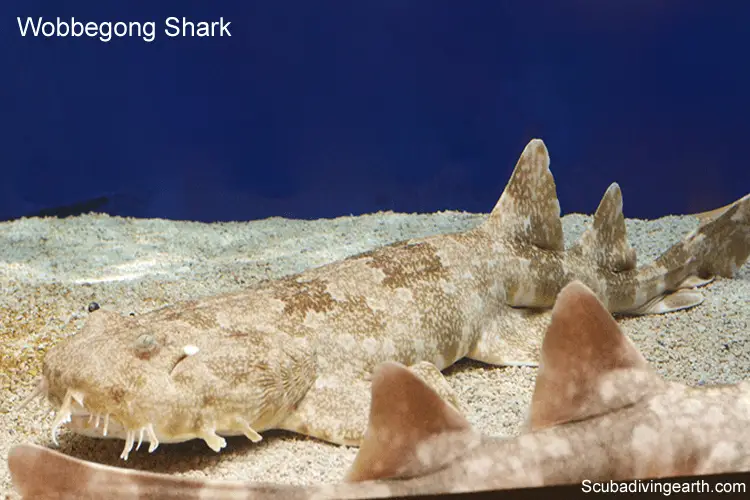
People often ask if the are any sharks on the Great Barrier Reef. The answer to this question is yes and in abundance too. In fact you can see over half of all the known shark species on this huge reef complex, which in total is around 370 species in the world.
The sharks you may see include the large Tiger Shark, which feed on the plentiful sea Turtles in the region. You may also be lucky to see hammerhead sharks.
However there’s more chance to see the various forms of reef shark. Reef sharks are the most commonly seen shark in the region and include the White-Tip Reef shark, the Black-Tip Reef shark and the Grey Reef sharks.
Other sharks include the unusual bottom dwelling Wobbegongs, as pictured above. Plus you may be lucky to see the largest of them all, the Whale Shark. There are also Manta Rays to be seen, which belong to the shark family of cartilaginous fish.
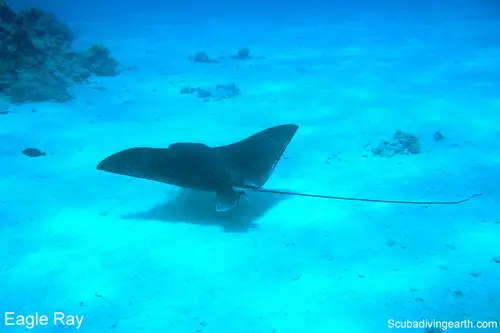
In addition to the Mantas you can see the beautiful Eagle Rays, with their trademark long tail and eagle-like head and spotted backs. Plus another spotted shark species, the Leopard Shark.
In fact The Great Barrier Reef is a scuba diver’s shark dream, as although there are never any guarantees of what sharks you may see, or if you’ll see any sharks at all, you have one of the best opportunities to see such a wide variety in one place.
A super friendly whale shark playing with some lucky divers. This baby whale shark seemed to really enjoy the bubbles from the divers and kept circling back for more! If you’re planning to learn to Scuba Dive in Koh Tao we recommend La Bombona Diving
This really friendly baby whale shark takes an interest in scuba divers in this amazing footage.
Do crocodiles live in the Great Barrier Reef?
It’s unlikely you’d ever see a Saltwater Crocodile on the Great Barrier Reef. However, Saltwater Crocodiles (Salties) live in the waters and along the coastline of Queensland, in the Mangrove and salt marshes.
For example, in this article in Australian’s Courier Mail: “The 24-year-old crayfish diver on Australia’s Great Barrier Reef has captured hours of extraordinary footage of himself swimming up close with deadly saltwater crocodiles, sharks, and snakes.” However, he spends his time in the far north in Cape York.
Australia dive liveaboards the best way to experience the Great Barrier reef
Probably the best way to experience the Great Barrier reef is by liveaboard. You’ll have more opportunity to scuba dive and you’ll get to dive sites that are out of reach of the day boats. Experience the outer Great Barrier Reef and enjoy the magic of the life and wonders you’ll discover.
To find out more about Australia liveaboards on the Great Barrier Reef, please follow either of the following links:
Liveaboard.com – Click here to find the perfect Australian liveaboard and to confirm prices and availability.
Dive-the-world.com – Click here to find the perfect Australian liveaboard and to confirm prices and availability.
I hope you enjoyed this article about what is the best time to visit the Great Barrier Reef
I’d love to hear from you. Tell us about your adventures of diving and snorkeling, in the comments below. Please also share your photos. Either from your underwater cameras or videos from your waterproof Gopro’s!
If this article hasn’t answered all of your questions. If you have more questions either about snorkeling or scuba diving (or specifically about what is the best time to visit the Great Barrier Reef), please comment below with your questions.
There will also be many more articles about scuba diving (and snorkeling) for you to read and learn about these fabulous sports.
Have fun and be safe!

